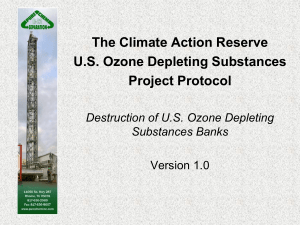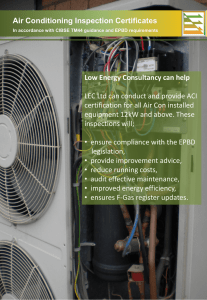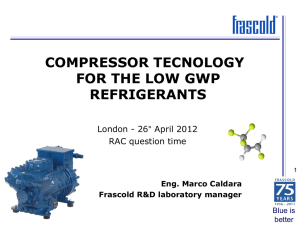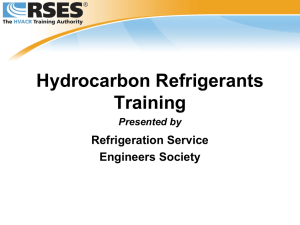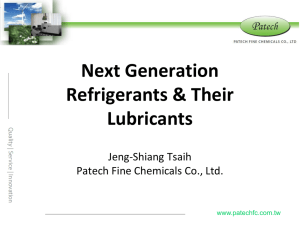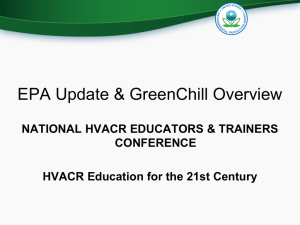Refrigerant conservation programs in
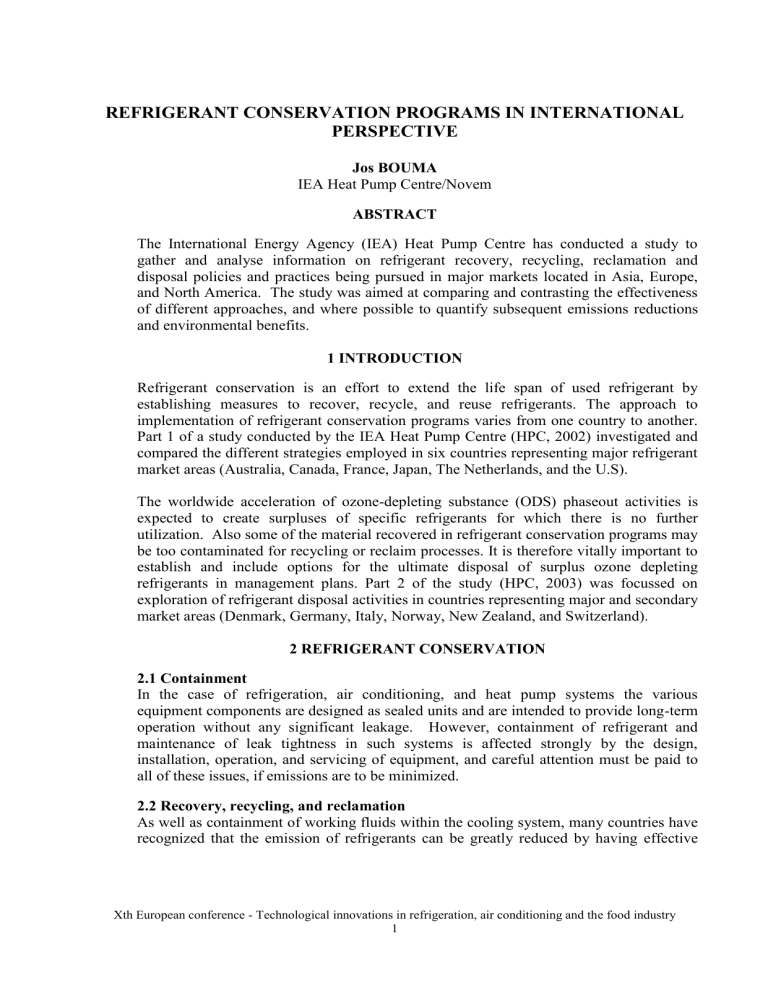
REFRIGERANT CONSERVATION PROGRAMS IN INTERNATIONAL
PERSPECTIVE
Jos BOUMA
IEA Heat Pump Centre/Novem
ABSTRACT
The International Energy Agency (IEA) Heat Pump Centre has conducted a study to gather and analyse information on refrigerant recovery, recycling, reclamation and disposal policies and practices being pursued in major markets located in Asia, Europe, and North America. The study was aimed at comparing and contrasting the effectiveness of different approaches, and where possible to quantify subsequent emissions reductions and environmental benefits.
1 INTRODUCTION
Refrigerant conservation is an effort to extend the life span of used refrigerant by establishing measures to recover, recycle, and reuse refrigerants. The approach to implementation of refrigerant conservation programs varies from one country to another.
Part 1 of a study conducted by the IEA Heat Pump Centre (HPC, 2002) investigated and compared the different strategies employed in six countries representing major refrigerant market areas (Australia, Canada, France, Japan, The Netherlands, and the U.S).
The worldwide acceleration of ozone-depleting substance (ODS) phaseout activities is expected to create surpluses of specific refrigerants for which there is no further utilization. Also some of the material recovered in refrigerant conservation programs may be too contaminated for recycling or reclaim processes. It is therefore vitally important to establish and include options for the ultimate disposal of surplus ozone depleting refrigerants in management plans. Part 2 of the study (HPC, 2003) was focussed on exploration of refrigerant disposal activities in countries representing major and secondary market areas (Denmark, Germany, Italy, Norway, New Zealand, and Switzerland).
2 REFRIGERANT CONSERVATION
2.1 Containment
In the case of refrigeration, air conditioning, and heat pump systems the various equipment components are designed as sealed units and are intended to provide long-term operation without any significant leakage. However, containment of refrigerant and maintenance of leak tightness in such systems is affected strongly by the design, installation, operation, and servicing of equipment, and careful attention must be paid to all of these issues, if emissions are to be minimized.
2.2 Recovery, recycling, and reclamation
As well as containment of working fluids within the cooling system, many countries have recognized that the emission of refrigerants can be greatly reduced by having effective
Xth European conference - Technological innovations in refrigeration, air conditioning and the food industry
1
recovery recycling and reclamation (R/R/R) programs in the refrigeration and air conditioning industries. The implementation of recovery/recycle measures and an infrastructure for reclamation of refrigerants is critical for those countries needing to meet consumption phaseout of ODS, while also striving to ensure continuity of dwindling supplies of necessary refrigerants needed to satisfy existing and future equipment servicing requirements.
2.3 Disposal
Requirements for the R/R/R of refrigerants have now been implemented for several years in different countries and have shown encouraging results in terms of emission reductions.
Further improvements in this area can be expected as programs become more effective and widespread, and as regulations are strengthened.
However, not all of the product recovered is suitable for reuse, and where for technical, financial or regulatory reasons the ODS can not be recycled it must be destroyed. (By definition Disposal means the destruction of used refrigerant in an environmentally responsible manner.)
3 REFRIGERANT DESTRUCTION
3.1 Regulations
Many countries require that recovered ODS be sent to specific destruction facilities.
Countries tend to regulate ODS based upon the end-use sector in which they are used. In the case of refrigerants some countries require that ODS refrigerants be removed from equipment (for example household refrigerators), recovered, and in some cases destroyed before such equipment can be disposed of.
Governments that are parties to the Montreal Protocol require that the destruction of ODS is done using technologies approved by the Protocol. Most of the technologies used today can be grouped under the categories of incineration technologies and plasma technologies.
3.2 Potential for ODS destruction
The potential for refrigerant destruction is derived from refrigerant recovered during service and refrigerant recovered at the end of life of the equipment. The UNEP Task
Force on Destruction Technologies (TFDT) has analyzed the potential of CFCs available for destruction and estimates indicate that the relatively large quantity that becomes available for destruction in the period 2002-2004, i.e. 5,000-6,000 tonnes annually, originates largely from Western Europe. For the same period an average quantity of CFC of approximately 8,400 tonnes per annum will become available worldwide for destruction. This clearly displays the result of the European regulation 2037/2000 (EC,
2037/2000), which does not allow charging of refrigeration equipment after service with
CFCs, nor export of recovered CFCs. Consequently, it is expected that CFC phaseout in
Europe will be rapid, with complete destruction of the recovered refrigerant.
For the period 2002-2004, about 65% of the amount that becomes available for destruction comes from large industrial and other equipment and from chillers, approximately 17% from domestic refrigerators, 11% from commercial equipment and the
Xth European conference - Technological innovations in refrigeration, air conditioning and the food industry
2
remainder from mobile air conditioning. This picture has changed by the year 2010 when more than 50% becomes available from domestic refrigerators and virtually all the rest from large industrial equipment and chillers.
4 ASSESSMENT RESULTS
4.1 Refrigerant recovery, recycling and reclamation
The United States program on refrigerant R/R/R is representative of a centralised government controlled system where regulations are developed, imposed, monitored and enforced by a federal government body, in this case the U.S. Environmental Protection
Agency (EPA). Stationary refrigeration and air conditioning equipment is regulated by the
National Recycling Rule under Section 608 of the Clean Air Act of 1990. In 1998 a supplementary rule became effective, which provided regulations governing substitutes for CFC-12, including HFC-134a and refrigerant blends containing HCFCs. Technicians must use EPA-certified equipment to recover the refrigerant and either recycle it on-site or send it to a reclamation facility for purification in accordance with ARI Standard 700.
In Australia , Refrigerant Reclaim Australia (RRA), a not-for-profit industry-funded organisation was established that recovers, reclaims and destroys ozone-depleting refrigerants. RRA is strongly supported by key industry participants, involving importers and wholesalers of refrigerants, and relevant industry associations such as equipment manufacturers and contractors. This inclusiveness is considered to be a major factor in the success of the program. The role of RRA is to collect, reclaim, or destroy unwanted and contaminated material. Also the concept of recycle and reuse of refrigerants is widely promoted.
For the EU countries the mandatory regulation 2037/2000 is in place prohibiting any further use of CFCs.
In the Netherlands the government imposed mandatory regulations for the prevention of refrigerant emissions in 1993. The regulation is an integrated program that is focussed on technical requirements for design, maintenance, and servicing of equipment necessary to reduce refrigerant leakage from installations. However, the strategy taken towards management of the program, including administration, funding arrangements and detailed content of the regulations is unique to the Dutch approach. The industry itself decided to establish compliance with the guidelines rather than leaving it to the government.
Measures adopted include certification for companies working on such installations, establishment of technical requirements necessary to reduce leakage, and training and education of field engineering staff. A private trade and industry organization (STEK) was established in 1991 to administer company certification and qualification of personnel, and to check for compliance. Owners or users of equipment containing CFCs, HCFCs, or
HFCs are required by law to have their equipment serviced and repaired by a company holding STEK certification.
The refrigerant conservation program in France is also controlled by the national government, and since 1992 a broad based set of regulations are in place mandating the recovery of CFCs, HCFCs, HFCs, and blends from all refrigeration, air conditioning, and heat pump equipment containing more than two kilograms of charge. Recycled product
Xth European conference - Technological innovations in refrigeration, air conditioning and the food industry
3
may only be reused in the same system that it was recovered from. Companies involved in installing or servicing such equipment must be registered with the Ministère de l’Environnement, which administers the program. Evidence must be provided that technical employees have recognised qualifications and experience, and the recovery/recycle equipment used must be of acceptable standards. A new regulation is under development to supplement existing decrees. The new decree will establish measures necessary for the prevention of leakage and the requirements relating to R/R/R and destruction of CFCs, HCFCs, HFCs, and their mixtures. The proposed legislation includes provisions for the qualifications of personnel, refrigerant content labelling of equipment, obligations on refrigerant distributors to take back used product, penalties for non-compliance etc., and includes the requirement for destruction of CFCs and contaminated refrigerants that cannot be reclaimed. It is also proposed that HCFCs be destroyed after 01 January, 2015.
Requirements for certification of companies and equipment, training of technicians, and leak tightness inspection are all measures already included in the existing program in
Denmark and will be adopted in future under new agreements and legislation now under way in Norway and Switzerland . In Germany control of the program is more decentralized and typically involves collaboration between refrigerant producers and specialist recycling companies. Also there are no requirements there for certification of companies, equipment, and staff or for leak tightness inspections.
The refrigerant R/R/R program now in preparation in Italy will be somewhat different from most European models, in that the program will be mandatory with legislation imposed, monitored and enforced by the national government environment ministry.
Program elements will include certification of equipment and technicians, standards and procedures for collection and disposal centres, periodic equipment leakage checks, documentation requirements, etc., and penalties will be imposed for non-compliance. It is expected that the industry and collection centres will be self-supporting.
In Japan the voluntary program run by industry associations, which lacked regulations or enforcement, has been replaced. The Fluorocarbons Destruction Law was introduced in
April 2001 requiring mandatory recovery/disposal of ODS from commercial refrigeration and air conditioning equipment and automobile air conditioning systems. Legislation and program management are the responsibility of the Ministry of Economy, Trade and
Industry and the Ministry of Environment. The program includes certification of companies and technicians, and there are stiff penalties in place for non-compliance. At the same time the government enacted the Law for Recycling Home Appliances, with mandatory requirements for recovery of refrigerants from scrapped domestic refrigerators and air conditioners.
4.2 Environmental benefits
Evidence of reductions of refrigerant emissions directly attributable to the introduction of
R/R/R programs is difficult to find. Up to now no official monitoring of the effectiveness of these measures has occurred within the countries surveyed, and very little recent data are available.
Xth European conference - Technological innovations in refrigeration, air conditioning and the food industry
4
In the Netherlands monitoring projects involved a large sample of transport refrigeration units and commercial refrigeration systems. Refrigerant emissions were compared over time for units built before and after introduction of the Dutch regulatory program. In the case of transport refrigeration the refrigerant emission rate was reduced from an average of 6% of the charge per year down to 3%, and for selected supermarket systems the average emission rate was reduced from 15% of refrigerant charge to 3% on an annual basis. In another monitoring project 236 large refrigerating systems (average charge 2 tonnes) of various ages up to ten years old were inspected during 1994-1996. The average annual leakage rate was found to be 8.6%. More recent monitoring data has been gathered from a study, which was conducted for the government to investigate the volumes of CFCs, HCFCs, and HFCs being used throughout the country for refill purposes in all application sectors (excluding auto air conditioning and marine installations). Relating these data directly to refrigerant emissions it was concluded that the average annual leakage rate for the reference year 1999 was 4.8% (equivalent to approximately 615 tonnes nation-wide). However, the study revealed that the emissions were attributable to only 8% of the installations.
Refrigerant Reclaim Australia Limited has conducted an extensive survey to trace the paths of imported refrigerants through the sales and application chain to assess the amount and type of product that may be returned. Results indicated that contractors are recovering approximately 400 tonnes of product (CFCs and HCFCs) annually from systems during servicing. Of this amount about 300 tonnes is recycled and reused, with the remainder being delivered to RRA for reclamation or destruction. Since the start of the program
RRA has received 600 tonnes of product, most of that consisting of HCFC-22, CFC-11, and unintentional mixtures of refrigerants. The levels of returns for these three products continue to increase, whereas returns for CFC-12 are much less and are declining.
It was reported from Japan that 690 tonnes per year of CFCs are recycled or reclaimed for reuse in refrigeration and air conditioning equipment. This represents 56% of the total estimated recovered quantity of 1,230 tonnes per year. In April 2002, in the first year of the new Household Appliance Recycling Law, 603 tonnes of CFCs were recovered from domestic refrigerators and air conditioners and sent for destruction.
In the US the EPA has reported that certified refrigerant reclaimers processed 10.5 million pounds of CFCs and HCFCs in 1999.
Norway indicated that approximately 550 tonnes (mostly CFCs) were collected from the refrigeration industry between 1992 and 2002. Environmental authorities there estimated that this amounted to about 40% of the potential volume that could have been collected.
Most of the recovered product (about 85%) was incinerated.
The most recent data available on ODS recovery and destruction in Denmark is for the years 1997-1998. Thus in 1997: out of 31 tonnes of CFCs recovered, 19 tonnes were reused and 12 tonnes destroyed, and in 1998: 56 tonnes were recovered, 17 tonnes reused and 39 tonnes destroyed.
Switzerland reported a very rapid reduction of CFC consumption from a high of 510 tonnes in 1993 down to a low of 5 tonnes in 1996, followed by some modest increases
Xth European conference - Technological innovations in refrigeration, air conditioning and the food industry
5
since then. At the same time HCFC consumption went from a peak of 660 tonnes in 1992 to a low of 253 tonnes in 2000.
4.3 Refrigerant disposal
Refrigerant disposal programs are in force in half of the countries that responded to the survey. In the case of Australia, Canada, Denmark, Norway, and New Zealand their programs are all managed by industry-driven organizations, and funded by industry-wide levies on the sale of new ozone depleting refrigerants. On the other hand under the new law in Japan, program control rests with the government environmental ministries, but there too disposal costs incurred must be borne by equipment users.
Most countries reported having commercial access to facilities suitable for destruction of
ODS within their own borders, although New Zealand has an arrangement in place for shipment of its ODS refrigerants to Australia for destruction, and Italy is also planning to export its surplus CFCs for destruction purposes. In most cases the method of destruction used is high temperature incineration.
In Japan many different destruction technologies are used (at least 17 processes were identified). The Japanese government has issued manuals, to promote safe and environmentally sound management practices in the more than 30 ODS destruction facilities that operate in the country.
In the United States ODS are classified as hazardous wastes and their disposal is regulated under the Resource Conservation and Recovery Act of 1976. The Environmental
Protection Agency (EPA) is the federal government agency responsible for enforcement of the ODS treatment and disposal regulations.
Six countries involved in the survey were able to provide some information about the quantities of ODS being processed by destruction facilities. The total amounts reported add up to approximately 3,300 tonnes/yr. However, the contribution from European sources should probably be at least doubled to account for missing input from Denmark,
Italy, The Netherlands, plus other EU countries outside the survey (Belgium, Spain,
Portugal, Austria, UK, and Sweden). Allowing for additional unknown but significant contributions from Japan, US, and some other countries, it is conceivable that the real total amount may well approach the potential level of 8,800 tonnes/yr of CFCs to be destroyed worldwide in 2002.
5 CONCLUSION
Most countries surveyed have national programs and policies in place with regard to prohibition of the release of ODS, and similar certification requirements exist for the recovery, recycling, and reclamation of certain refrigerants. However, different approaches are taken to the avoidance of emissions, program organization and control, responsibility levels, regulatory legislation, financing arrangements, and operating procedures. Different strategies are followed to achieve emission reductions. In some countries government and industry have collaborated and defined an obligatory preventive emission control regime. With this approach preventive measures are taken to improve the
Xth European conference - Technological innovations in refrigeration, air conditioning and the food industry
6
leak tightness of systems and avoid the occurrence of refrigerant leakage, rather than repairing leaking equipment after emissions have already happened.
Information is generally weak or lacking on the issue of environmental and cost benefits occurring since the introduction of refrigerant R/R/R regulations, as no official before and after situation monitoring results have been reported to date. However, based on recent study data (e.g. France, Australia, The Netherlands) it is clear that these programs have proven to be effective so far in achieving significant reductions in refrigerant emissions.
As regards the disposal of surplus ozone depleting refrigerants the need for regulations with enforcement by government legislation has been clearly recognized. Amongst the 12 countries surveyed it was found that 10 had regulations either in force or planned requiring the disposal of ODS, most of these relating specifically to the destruction of
CFCs. For the EU member countries regulation includes a ban on the use of CFCs for refilling purposes, leading to the requirement for their destruction. Other countries including Canada, Norway and Switzerland are also moving towards imposing similar regulations with equipment refilling bans. Japan has recently passed two laws relating to these issues: one dealing with ODS recovery and destruction, and one covering recycling of used domestic appliance equipment.
None of the programs for surplus ozone depleting refrigerants are financed from government sources, and most are funded by levies on the sale of imported or manufactured ODS. For the most part programs are controlled by industry-driven selfsupporting organizations responsible for management, operation, funding, etc.
The predominant refrigerant destruction technology is high temperature incineration and the facilities utilized are typically multi-purpose, such as rotary kiln incinerators.
Significant quantities of CFCs are already being processed in some of the countries included in the survey. Information was incomplete on the amounts of CFCs recovered and destroyed, but a reasonable extrapolation from the data that was provided would indicate that the estimated global potential for CFC destruction of 8,800 tonnes in 2002 for example is likely to be an accurate one.
REFERENCES
EC, 2037/2000. Regulation of the European Parliament and of the Council on Substances that Deplete the Ozone Layer, June 2000.
HPC, 2002, Refrigerant Management Programs : An International Assessment – Part 1
Refrigerant Recovery, Recycling and Reclamation, IEA Heat Pump Centre, Sittard, 54 p.
HPC, 2003, Refrigerant Management Programs : An International Assessment – Part 2
Refrigerant Recovery, Recycling, Reclamation and Disposal , IEA Heat Pump Centre,
Sittard, 83 p.
Xth European conference - Technological innovations in refrigeration, air conditioning and the food industry
7
